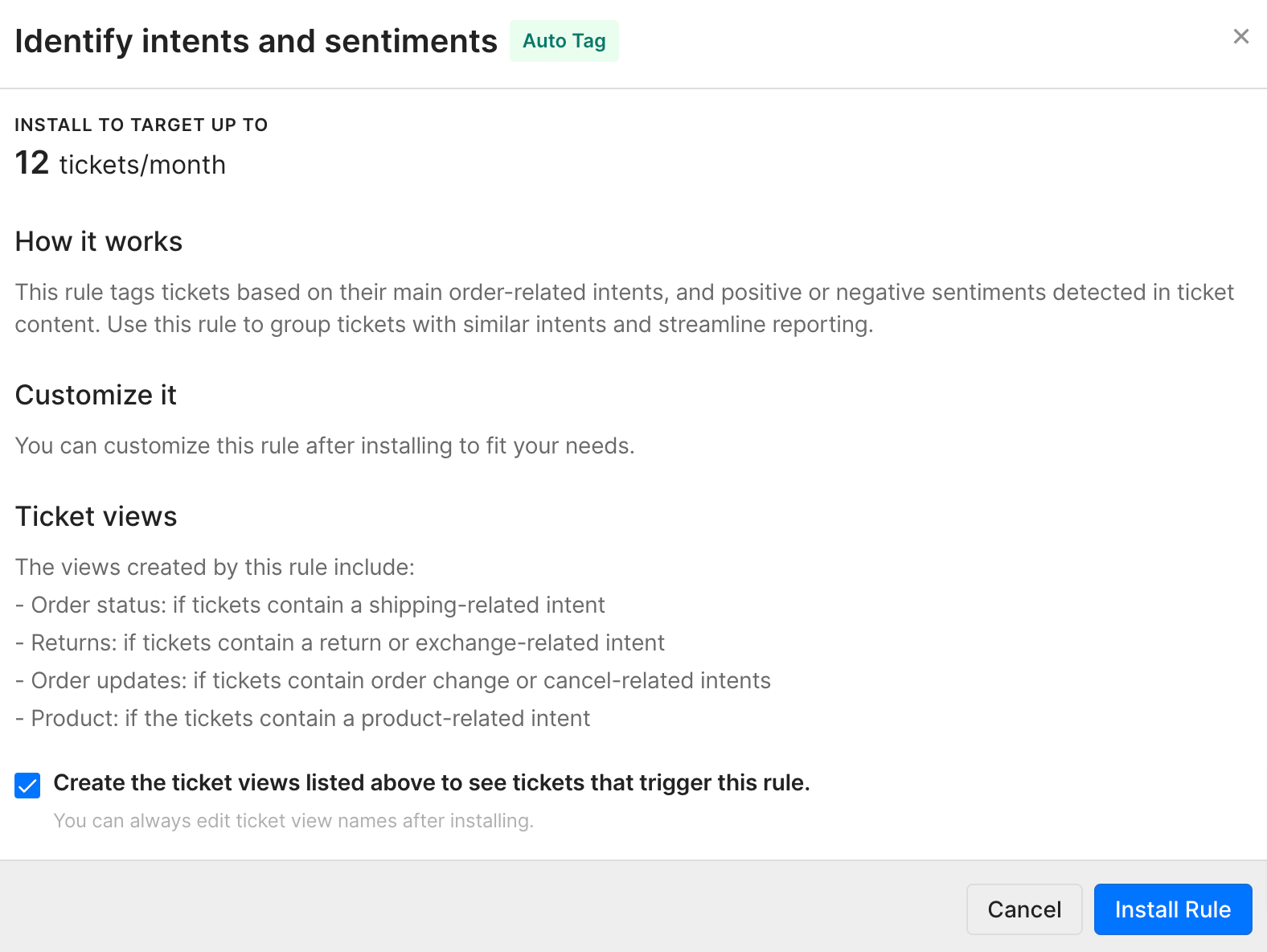Customer IntentsUpdated 2 years ago
If you want to automatically manage repetitive tasks - such as tagging tickets or responding to common questions - but don't want to spend a lot of time setting up complex Rules, you can use customer intent detection.
If you're not familiar with the basics of Rules in Gorgias, check out these articles before you get started.
Each time a new customer message arrives, our system will try to figure out the customer's intent and they can be used for your ticket-processing workflow.
List of customer intents
| Name | Description |
|---|---|
| discount/request | Asks for a discount or needs help applying it. |
| exchange/request | Requests to exchange a received product or get a replacement. |
| exchange/status | Requests a status update on an ongoing exchange. |
| feedback | The customer provides feedback on a product, brand, or customer service (can be combined with positive or negative sentiments for more fine-grain classification). |
| order/cancel | Requests to cancel an order before it ships. |
| order/change | Requests to edit an order before it ships. |
| order/damaged | The received order contains a damaged item or the customer needs help troubleshooting. |
| order/wrong | The received order contains a wrong item or is missing an item. |
| other/no-reply | A message that doesn't need a reply and can probably be closed. |
| other/question | A general question on a product, brand, or service. |
| other/thanks | The customer expresses gratitude and the ticket can probably be closed. |
| product/question | Question about a specific product. |
| product/recommendation | Requests help with choosing a product. |
| refund/request | Requests to process a refund. |
| refund/status | Requests a status update on an ongoing refund (can overlap with return/status). |
| return/request | Requests to return a received product. |
| return/status | Requests a status update on a received product. |
| shipping/change | Requests to change shipping information. |
| shipping/delivery-issue | Notifies of an error with a package. |
| shipping/policy | Asks for shipping information. |
| shipping/status | Asks for a status update on an expected order. |
| stock/request | Asks about the availability of a product. |
| subscription/cancel | Requests to cancel a subscription. |
| subscription/change | Requests to edit a subscription. |
Steps
You can automatically apply specific Tags to tickets via Rules to figure out easily if some tickets require extra attention.
Here's how to create a simple Rule to tag tickets using customer intents:
1. Navigate to Settings -> Productivity -> Rules and click Create Rule.
2. Under Rule Templates, select the Identify intents and sentiments template.
3. Here you can also let the helpdesk create matching Views for the various intents.
FAQs
How does intent classification work?
The Gorgias intent classification system is based on state-of-the-art artificial intelligence algorithms.
The intent found is wrong, what should I do?
Unfortunately, that can happen as language comprehension is hard - there are usually a lot of ways to say the same thing. You can combine message intents with simple logic for a better result.
Can a single message have multiple intents?
Yes, each message can have multiple intents. Besides, if you use intents to auto-tag tickets, tickets will be tagged with the intents of all messages it includes.
Do all messages have an intent?
No, there is a predefined list of possible intents. Moreover, when the system isn't confident about a prediction, it won't detect the intent.
Can I add an intent to the list of intents that can be detected?
If you have an intent that can't be detected, you can submit it as feedback on our Roadmap, in the top right.
Can I edit the intent in a ticket?
Yes, you can edit intents on ticket messages to enable you to achieve accurate numbers in the intents statistics by choosing a different intent from the dropdown menu in the top right of a message.
What languages are supported?
Intent detection works in the 16 most commonly spoken languages, so if the customer is writing over to you in another language, we can detect the keywords and trigger the Rule.
The currently supported languages are:
1. Arabic (ar)
2. Chinese (PRC) (zh)
3. Chinese (Taiwan) (zh-tw)
4. Dutch (nl)
5. English (en)
6. German (de)
7. French (fr)
8. Italian (it)
9. Portuguese (pt)
10. Spanish (es)
11. Japanese (ja)
12. Korean (ko)
13. Russian (ru)
14. Polish (pl)
15. Thai (th)
16. Turkish (tr)